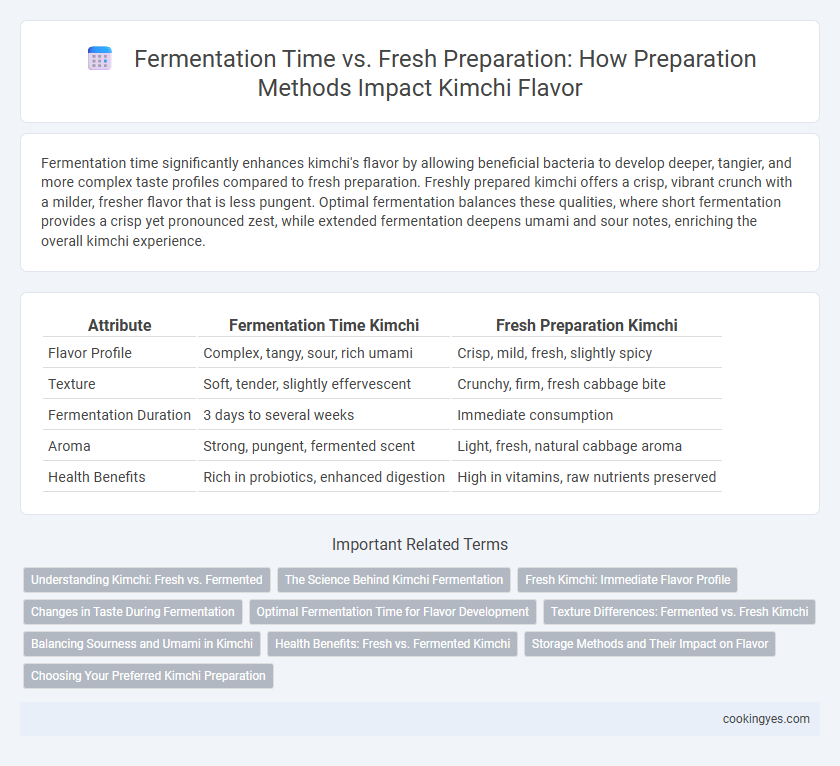Fermentation time significantly enhances kimchi's flavor by allowing beneficial bacteria to develop deeper, tangier, and more complex taste profiles compared to fresh preparation. Freshly prepared kimchi offers a crisp, vibrant crunch with a milder, fresher flavor that is less pungent. Optimal fermentation balances these qualities, where short fermentation provides a crisp yet pronounced zest, while extended fermentation deepens umami and sour notes, enriching the overall kimchi experience.
Table of Comparison
| Attribute | Fermentation Time Kimchi | Fresh Preparation Kimchi |
|---|---|---|
| Flavor Profile | Complex, tangy, sour, rich umami | Crisp, mild, fresh, slightly spicy |
| Texture | Soft, tender, slightly effervescent | Crunchy, firm, fresh cabbage bite |
| Fermentation Duration | 3 days to several weeks | Immediate consumption |
| Aroma | Strong, pungent, fermented scent | Light, fresh, natural cabbage aroma |
| Health Benefits | Rich in probiotics, enhanced digestion | High in vitamins, raw nutrients preserved |
Understanding Kimchi: Fresh vs. Fermented
Fresh kimchi offers a crisp texture and sharp, vibrant flavors due to minimal fermentation, typically consumed within one to two days of preparation. Fermented kimchi, aged from several days up to months at controlled temperatures around 4degC, develops complex, tangy, and umami-rich profiles as lactic acid bacteria transform sugars into acids. The duration of fermentation directly influences acidity, texture, and probiotic content, making flavor depth and health benefits increasingly pronounced over time.
The Science Behind Kimchi Fermentation
Kimchi fermentation time significantly influences its flavor profile due to microbial activity converting sugars into acids, enhancing umami and sourness. Short fermentation produces a crisp, mildly tangy taste, while extended fermentation deepens complexity through lactic acid bacteria proliferation, primarily Lactobacillus species. The science behind kimchi fermentation reveals that temperature and duration critically modulate metabolic pathways that develop optimal flavor and texture.
Fresh Kimchi: Immediate Flavor Profile
Fresh kimchi offers a vibrant and crisp texture with a sharp, tangy flavor dominated by the natural sweetness of napa cabbage and spices. The immediate flavor profile highlights the pungency of raw garlic, ginger, and chili peppers before lactic acid fermentation softens these bold notes. Consuming kimchi fresh preserves its crunchy bite and enhances the brightness of the vegetable flavors compared to the mellow, sour taste developed during extended fermentation.
Changes in Taste During Fermentation
Kimchi undergoes significant flavor transformation during fermentation, as lactic acid bacteria convert sugars into organic acids, producing a tangy and complex taste profile. Freshly prepared kimchi offers a crisp, spicy, and mildly salty flavor with vibrant crunch, whereas extended fermentation enhances sourness, umami depth, and softer texture due to enzymatic breakdown of vegetables. Optimal fermentation time varies from a few days to several weeks depending on temperature and desired taste intensity, with longer fermentation yielding richer probiotic benefits and mature flavor complexity.
Optimal Fermentation Time for Flavor Development
Kimchi's optimal fermentation time ranges from 3 to 7 days at approximately 20degC, allowing beneficial lactic acid bacteria to develop complex flavors and a balanced tangy aroma. Freshly prepared kimchi offers a crisp texture and mild flavor, but extended fermentation enhances umami depth and sourness, which are key to authentic taste. Controlling fermentation duration and temperature precisely ensures peak flavor development without overpowering sourness.
Texture Differences: Fermented vs. Fresh Kimchi
Fermented kimchi develops a softer, more tender texture due to the breakdown of vegetables by lactic acid bacteria over weeks or months, creating a complex, tangy flavor profile. Freshly prepared kimchi retains a crisp, crunchy texture with a sharper, more pungent taste that highlights the raw ingredients. The contrast between fermentation time directly affects the texture, balancing firmness and softness to suit different culinary preferences.
Balancing Sourness and Umami in Kimchi
Fermentation time plays a crucial role in balancing sourness and umami in kimchi, as longer fermentation enhances lactic acid production, resulting in a tangier flavor profile. Freshly prepared kimchi offers a crisp, mildly sweet taste with subtle umami notes from ingredients like garlic and fish sauce. Optimal flavor development typically occurs after 1 to 2 weeks of fermentation at refrigeration temperatures, allowing sourness to deepen while umami compounds intensify.
Health Benefits: Fresh vs. Fermented Kimchi
Fermented kimchi contains higher levels of probiotics and bioactive compounds that enhance gut health and boost the immune system compared to freshly prepared kimchi. The fermentation process increases beneficial lactic acid bacteria, which aid digestion and produce antioxidants, whereas fresh kimchi provides more vitamin C but lacks these probiotic benefits. Regular consumption of fermented kimchi supports a healthier microbiome and improved nutrient absorption, making it superior for long-term health benefits.
Storage Methods and Their Impact on Flavor
Proper storage methods significantly influence kimchi's flavor development during fermentation time compared to fresh preparation. Refrigeration slows fermentation, preserving crispness and mild tanginess, while room temperature storage accelerates fermentation, enhancing sourness and complexity. Airtight containers minimize oxidation and unwanted microbial growth, ensuring consistent flavor profiles throughout the fermentation process.
Choosing Your Preferred Kimchi Preparation
Fermentation time significantly influences kimchi flavor, with shorter periods producing a crisp, fresh taste and longer fermentation yielding a deeper, tangy complexity. Freshly prepared kimchi offers a vibrant crunch and mild spice, ideal for those seeking a lighter profile, while fermented kimchi develops rich umami notes favored in traditional Korean cuisine. Selecting your preferred preparation depends on desired sourness, texture, and intensity of flavor in your kimchi experience.
Fermentation time vs fresh preparation for kimchi flavor Infographic

 cookingyes.com
cookingyes.com